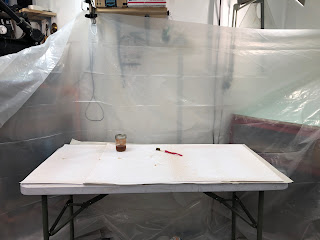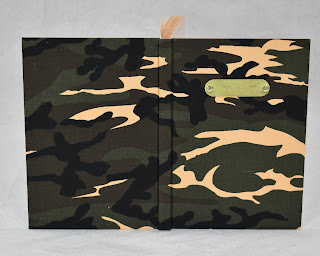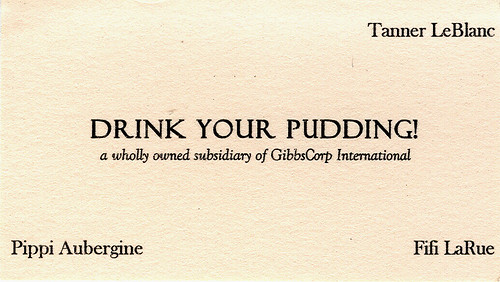Field Guide is a two volume artist's book edition that traces mankind's fractured relationship with nature, stemming from our difficulty in recognizing that we are, in fact, a part of nature.
production notes below description
Volume 1, Field Guide, has the abridged text of Man, A Machine, written by Julien Offray de La Mettrie in 1747, and a thorough range of historic skeleton illustrations, presented in the order of the traditional "evolutionary tree of life" that has biology reaching its pinnacle in modern day human beings. It is covered in rabbit fur (various patterns).
Volume 2, Field Guide to the Anthropocene, uses historic Field Guides covering a range of topics, to depict visually how humans have continued to insist on describing the natural world through how it specifically affects humans; it is also organized internally in the same order as Volume 1, starting with plants and ending with human beings (and war). The cover material is a camouflage fabric.
The pages of both volumes were digitally printed, then hand dyed using tea, walnut husks, and hibiscus flowers. Edges painted. Titles engraved on brass tags, mounted into front covers.
Limited edition of 15. Two volumes in clamshell box. 2019/2021 | Codex 2022, booth 50
Work on this project started in the spring of 2019. Do you remember those heady early spring days? I was just about to depart for Seattle, and in the planning stages of a trip to Japan (Seattle was full of delicious pastries, Japan is still in the future).
At the time, I had two fuzzy cats, Ferdinand and Charlie. Now, I have two tuxedo cats, Ezra and Vincent. Obviously, other things have happened in the intervening two and a half years, which accounts for why it has taken said amount of time to finish this edition, but let’s just spend a moment admiring the cats.
The entire project was undertaken because I wondered — how do you cover a book in fur? Whenever I see a book as a prop in a film, I’m filled with [occasionally irrational] envy that I was not the person who made that prop, and I want to have the skill set to be able to do literally anything that a prop master requests, regardless of whether it’s a thing that I’ve done before or not. And that Harry Potter book really made me want to know … how do you do that? There aren’t any bookbinding how to manuals that really go into working with weird materials, but I’ve never let that stop me before — even back in graduate school, I used a rattlesnake skin on an artist’s book just because I wanted to see how it would work (it worked).
In order to figure out how to even work with fur, I ended up using the extensive tailoring collection at the LAPL — books published in the 1930s and 1940s that provided directions on how working with fur is different from working with leather or cloth. While there are significant differences between a goatskin that has been tanned specifically for use in bookbinding and fur for the clothing trade, it was at least a starting point for how the material behaved and what types of technical issues would need to be addressed.
Oddly enough, in one of those moments of synchronicity that make you wonder if the universe is paying a bit too much attention, as these books were nearing final completion, the New Yorker published an article about Margaret Wise Brown, and discussed how she had enough clout with her publishers to insist that the first run of Little Fur Families be covered in rabbit skin, with later editions in fake fur. I had spent two years looking for examples of fur in bookbinding, and suddenly, here was one, unexpectedly. Unfortunately, the first editions were missing from both the LAPL and UCLA special collections, and the other library copies are in traditional laminated covers, but the Beverly Hills public library had a copy of a recent fake fur edition, which was at least something to study to see how the internal structure and turn-ins were handled.
Once I had worked through enough of the technical issues regarding the material, I began to think about this as an artist’s book edition. If I wanted to cover a book in fur, what should the content be?
Obviously, the content should be bones.
After I had amassed a geological quarry’s worth of skeletons, I started thinking about the text. I wanted … a bone identification guide? An excavation guide? A field guide? The more I looked into field guides, the more I realized that a field guide of field guides was a fascinating lens through which to tell the story of how mankind has defined the natural world around the needs of humanity. So while looking for text for volume one (bones), I inadvertently created volume two (field guide of field guides).
This still left me with the question of how to give the skeletons context, so I started reading natural history and philosophy concerning the ability of humanity to see itself as separate from all other aspects of creations. This belief stems from the very first chapters of Genesis, where it is declared that man was created in god’s own image, and has led to millennia of exploitation of natural resources and cruelty to animals (and women, who were seen as closer to animals than to men). (Even today I’ve met [had first but not second dates with] people who believe that humans are somehow more than other animals.) In doing this reading, I came across the essay Man, A Machine, by the French philosopher Julien Offray de La Mettrie, writing in the 18th century that, nope, we’re just functional organisms like everything else. He was excommunicated for this. I loved this essay, and the writing style, but in abridging it for this project, I removed most of what he had to say about the intellectual powers of women. (He was on the right track, but it was still the 18th century, and women were still property.)
Now that I had the collection of skeletons, the essay, and the collection of Field Guides, I started working on page layouts for the text. The skeletons are arranged in the order of the traditional “tree of evolution,” which sees, as its pinnacle, the development of modern mankind.
The skeletons face the inner margin, with the text swimming around the outer margins, and evolve from fish to birds to mammals to apes to humans.
In the second volume, the Field Guides start with plants, then works through the same order as the skeletons — fish, birds, mammals, humans — ending with that most human of creations, war.
I experimented with different page color backgrounds, and settled on tea-dying the pages as a way to bring texture into the digital printing.
... time passed ...
To begin the process of dying the pages, strong tea was made, and the pages were dipped for about a minute and then line dried.
After they had dried, there still just wasn’t quite enough texture to the paper surface, so I experimented with other types of dyes.
Using a speckled effect in walnut husk and hibiscus provided the level of visual softening that I was looking for.
After the pages were dyed, speckled, dried, pressed, and trimmed, the edges were painted a dull gold that adds more visual texture rather than shine.
Which brought me back to the process that started it all — covering the books with fur. It really isn’t like working with leather. For a lot of the process, you’re working just by feel — because the fur obscures everything that the skin is doing. While my techniques were informed by my research and previous experiments, they were, honestly, also informed by growing up in Dallas in the 1980s. Let’s just say that I hadn’t bought hair spray since I was in high school, and some of the turn-in trimming techniques owe more to the concept of the Flowbee than to any bookbinding techniques.
The engraved brass name tags were the result of wondering how to attach a title to fur, my previously experiments therein being lackluster, but it was resolved through a lifetime of having fuzzy feline companions. The hand-stamped unevenness that the dog supplier produced I found charming and in keeping with the feel of the book.
And so the edition is completed [the clamshell boxes are still in process]. I feel it is important to note that I did strongly consider using imitation fur for this edition: while this book’s nickname has definitely been the hunter and the wabbit, I’m very aware of the ethical and environmental issues associated with the use of fur. I live in a state where SB-5 strictly regulates the sale and use of fur. While I’m not a vegetarian — while I use goat and calf frequently in my bookbinding practice — there is a definite ick factor that happens simultaneously with the ooo fuzzy reaction. I think this is important. I want readers to be equally fascinated and appalled: that is the crux of the anthropocene, a world that we’ve created in our own image, that is slowly destroying our ability to continue to survive.




























